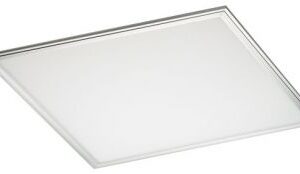LED Lighting
The Role of LED Lighting in Suspended Ceilings: Benefits, Applications, and Trends
Suspended ceilings, or dropped or false ceilings, are widely used in modern commercial, industrial, and residential settings. They provide a clean, aesthetically pleasing appearance, conceal wiring and HVAC systems, and improve acoustics. Over recent years, one of the most significant innovations in lighting design has been integrating LED (Light Emitting Diode) lighting into suspended ceilings. LED technology offers numerous advantages, making it an ideal choice for illuminating these ceiling systems. The article at the bottom of the page explores the benefits, applications, and trends surrounding LED lighting in suspended ceilings.
Showing all 4 results
-

20W CIRCULAR LED PANEL – AVAILABLE IN THREE SHADES OF WHITE
£20.00 + VAT Add to basket -

34W 600mm X 600mm daylight 6000K Led Recessed Module
£22.00 + VAT Add to basket -

34W 4000K Cool-light 600mm X 600mm Led Recessed Module
£22.00 + VAT Add to basket -

40w LED Polo Light
£22.00 + VAT Add to basket
Why Choose LED Lighting for Suspended Ceilings?
- Energy Efficiency
LED lights are highly energy-efficient. LEDs use up to 80% less energy while producing the same light as traditional incandescent or fluorescent lighting. This energy efficiency is critical in suspended ceilings, where lighting is often needed for large areas such as office buildings, shopping malls, hospitals, and schools. Businesses and homeowners can lower electricity bills and reduce their environmental footprint by reducing energy consumption. - Longevity and Durability
LED lights last much longer than traditional bulbs, often reaching 25,000 to 50,000 hours or more. In contrast, incandescent and fluorescent bulbs typically need replacement every few thousand hours. In suspended ceiling installations, this longevity reduces the frequency of maintenance, saving both time and money. Additionally, LEDs are more durable and resistant to damage from vibration or impact, making them ideal for commercial and industrial environments. - Compact and Flexible Design
LED lights are small, compact, and versatile, easily integrated into various suspended ceiling designs. Whether used in recessed light fixtures, linear light strips, or panel lights, LEDs offer flexible lighting options that fit different ceiling configurations. Their slim profile allows them to blend seamlessly into the grid system of a suspended ceiling without occupying valuable space. - Improved Lighting Quality
LED lights provide excellent colour rendering, ensuring objects’ colours appear natural and vibrant. This feature is particularly important in environments where accurate color perception is essential, such as retail stores, art galleries, or medical facilities. LEDs also come in various colour temperatures, from warm to cool white, allowing greater control over a space’s ambience. LEDs deliver the perfect light whether you need a cosy, inviting atmosphere or a bright, high-energy workspace. - Low Heat Emission
Traditional light bulbs, especially incandescent and halogen types, generate significant heat, which can increase air conditioning costs in enclosed spaces. LED lights, on the other hand, produce very little heat. This characteristic makes them ideal for use in suspended ceilings, where maintaining a comfortable indoor temperature is crucial. The low heat output of LEDs also reduces the load on HVAC systems, improving overall energy efficiency.
Applications of LED Lighting in Suspended Ceilings
LED lighting fits a wide range of applications within suspended ceiling systems. Here are some common ways that LED lights are used:
1. Recessed Lighting
Recessed LED fixtures are popular in suspended ceilings. These fixtures sit flush with the ceiling grid, providing a clean, unobtrusive look. They are ideal for spaces that require general lighting without bulky light fixtures hanging down. Recessed LEDs are commonly used in offices, conference rooms, hospitals, and retail environments.
2. Linear LED Panels
Linear LED panels offer sleek, continuous lighting and are typically installed in long rows across the ceiling grid. These fixtures provide uniform illumination and are ideal for commercial and industrial spaces like hallways, classrooms, and open-plan offices. Linear LEDs are particularly effective in areas where both ambient and task lighting are required.
3. LED Troffers
Troffer lights are rectangular light fixtures commonly integrated into suspended ceiling grids. LED troffers offer energy-efficient lighting solutions for large spaces, such as office buildings, schools, and healthcare facilities. They provide even light distribution, critical in environments requiring bright, uniform lighting over vast areas.
4. Accent and Decorative Lighting
LED strips or spotlights can create accent lighting effects within suspended ceilings. These lights integrate into architectural features like cove ceilings or custom fixtures. Decorative LED lighting adds a modern, aesthetic appeal to commercial and residential spaces, highlighting specific areas or creating mood lighting.
5. Emergency and Exit Lighting
Suspended ceilings often incorporate emergency and exit lights as part of building safety codes. LEDs make an excellent choice for these applications due to their reliability, low maintenance, and energy efficiency. In emergencies, LED lights provide bright, clear lighting to guide occupants safely out of the building.
Emerging Trends in LED Lighting for Suspended Ceilings
As LED technology continues to evolve, new trends and innovations are shaping the future of suspended ceiling lighting. Here are a few key trends:
1. Smart Lighting Integration
As intelligent building technologies rise, more LED lighting systems integrate into IoT (Internet of Things) networks. Smart LED lights can be controlled remotely, adjusted for brightness, and set to different colour temperatures based on the time of day or occupancy. This control enhances energy savings, optimizes lighting quality, and improves the user experience.
2. Human-Centric Lighting (HCL)
Human-centric lighting creates environments that support well-being, productivity, and health. LED lighting systems can now mimic natural daylight, adjusting colour temperature and intensity throughout the day to regulate circadian rhythms. This approach is especially beneficial in workplaces, healthcare environments, and schools, where lighting impacts mood, focus, and overall comfort.
3. RGB and Tunable Color LEDs
The use of colour-changing LEDs has gained popularity in decorative and commercial lighting. RGB (Red, Green, Blue) LEDs allow users to adjust the light colour to suit different moods or purposes, creating dynamic lighting effects in suspended ceiling designs. Tunable white LEDs also enable adjustments from warm to cool, offering flexibility for both functional and aesthetic needs.
4. Integration with Ceiling Materials
Modern suspended ceiling designs increasingly incorporate LED lighting directly into the ceiling materials. For example, light-transmitting ceiling tiles can embed LED strips, allowing light to filter through the tiles in a soft, diffused manner. This integration enhances the overall aesthetic while keeping the lighting functional and discreet.
Conclusion
LED lighting transforms how we illuminate suspended ceilings, offering energy efficiency, durability, and versatility. LEDs provide solutions for various commercial and residential spaces, from recessed and linear panels to emergency lighting and decorative accents. As new advancements in intelligent and human-centric lighting emerge, LEDs will continue to play an integral role in shaping modern, sustainable, and user-friendly environments.

 Cart is empty
Cart is empty 





